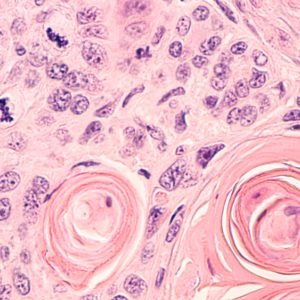Histological Types of Mesothelioma: Forms of Mesothelioma Cells

Mesothelioma is a difficult disease to diagnose. The generalized nature of the symptoms means that mesothelioma is often mistaken for a less serious illness — a disturbing reality for patients because mesothelioma is an aggressive cancer for which there is currently no cure. To make an accurate diagnosis, doctors need to identify exactly what type of pathological cancer cells are present. The examination of these microscopic cells is called histology.
Why Histology Is Important
Histology, or histopathology, is essential to define cancer cells at their most basic level. Treatment options for mesothelioma may differ based on what types of cells (e.g., epithelioid, sarcomatoid or biphasic) make up the tumor. Understanding cell types is also important in outlining prognoses and life expectancies for people with the asbestos cancer.
Finding out the cell type(s) is done through a biopsy of the diseased tissue. Depending on the location of the mesothelioma tumor, a tissue sample may be taken in a quick outpatient procedure. Other biopsies may be more invasive and require a hospital stay.
Regardless of whether the cancer is pleural, peritoneal, pericardial or testicular, histology is a vital part of the diagnostic process for mesothelioma.
Biopsy Types for Malignant Mesothelioma
There are several different types of biopsy procedures that can be used to make a mesothelioma diagnosis. A doctor decides what type of biopsy is appropriate after a thorough physical examination and viewing the results of imaging tests (e.g., X-rays, CT scans, PET scans, MRIs).
Doctors aim to do the most minimally invasive biopsies possible for their patients. That is particularly true for those who are already weakened by a potentially serious illness like mesothelioma. Some types of biopsy procedures include:
Minimally Invasive Biopsies
Video-assisted thoracoscopy surgery (VATS)
 A surgeon makes three small incisions to insert a camera and surgical tools in the chest cavity. A chest sample is then taken from the diseased tissue.
A surgeon makes three small incisions to insert a camera and surgical tools in the chest cavity. A chest sample is then taken from the diseased tissue.
In 2014, the results of a study in the journal Chest found that an outpatient thoracoscopy to examine the lining of the chest cavity was a very effective procedure for those with suspected pleural mesothelioma.
Mediastinoscopy
A tube and camera are inserted through small incisions to remove tissue from the front or middle of the chest. This procedure aims to access the area between the lungs. It is also possible to sample the nearby lymph nodes, which can help determine if the cancer has spread.
Laparoscopy
A small incision is made in the abdomen to explore the abdominal cavity for cancerous tissues.
More Invasive Surgical Biopsies
Thoracotomy
A surgeon makes an incision to fully open the chest cavity. This procedure enables the doctor to take samples from several areas.
Laparotomy
Doctors open the abdominal area to collect tissues for a peritoneal mesothelioma diagnosis.
Surgical Resection
Doctors try to remove as much of the cancer as possible. Pathologists examine the tissues to gather more information about the disease.
Other Biopsy Options for Mesothelioma Diagnosis
In some cases, a doctor may opt to perform a biopsy using other methods. Some of these include looking at fluid samples, in a subspecialty of pathology called cytology:
Needle Biopsy
 A long, thin needle is inserted into the affected area, and cancerous fluid is removed.
A long, thin needle is inserted into the affected area, and cancerous fluid is removed.
Fluid Removal
In many cases of mesothelioma, there is fluid build-up in the area surrounding the cancer. Using a needle, doctors can extract fluid from the affected areas. In addition to analyzing the fluid, fluid removal can relieve discomfort for patients and may become part of palliative care.
Cytology may be the first step that a doctor takes to gather information about mesothelioma because the procedures are minimally invasive. But the science of cytology is currently not considered as accurate as a histological sample to diagnose mesothelioma.
Types of Mesothelioma Cancer Cells
Generally, mesothelioma cells can be categorized into three histological cell types ― epithelioid, sarcomatoid and biphasic. Each type has it own unique characteristics and varies in its response to treatment. For this reason, it is very important for doctors to get a good sample of tissues during biopsy to pinpoint what kind of mesothelioma they are dealing with.
Epithelioid Mesothelioma
Epithelioid mesothelioma is made up of epithelial tissue, a type of tissue that can be found all over the body. The skin is entirely composed of epithelial tissues. It also lines all internal and external organs. When a person inhales or swallows asbestos fibers, the fibers dig in to the epithelial tissues and get stuck. When this happens, there is a greater risk of malignancy over time.
Epithelioid cancer cells are epithelial cells that have malfunctioned and multiplied. Epithelioid mesothelioma is the most common type of asbestos cancer, occurring in 70 percent of cases. It is also the most treatable form of the disease, and more treatment options are available the earlier it is diagnosed.
Because of the wide distribution of epithelial cells throughout the body, epithelioid mesothelioma can mimic many more common forms of cancer. In particular, it may be mistaken for:
- Adenocarcinoma of the lungs, breast or colon
- Pneumonia
- Bronchitis
- Asbestosis (a benign but chronic asbestos-related lung condition).
It is very important for patients to report any history of asbestos exposure to their doctors during their first examinations to make sure that mesothelioma is considered as a possibility.
Sarcomatoid Mesothelioma
Sarcomatoid mesothelioma is the deadliest type of the three histopathological types. It is also the rarest form of mesothelioma, occurring in 7 to 20 percent of all cases.
 The spindle-shaped sarcomatoid cells are spaced farther apart than epithelial cells, making these cancer cells more likely to spread throughout the body. Unlike epithelial cells that attack the membranous tissue around body parts, sarcomatoid cells affect the bones, muscles and cartilage. They also differ from epithelioid cells because they appear like nodules or lesions, not localized tumors.
The spindle-shaped sarcomatoid cells are spaced farther apart than epithelial cells, making these cancer cells more likely to spread throughout the body. Unlike epithelial cells that attack the membranous tissue around body parts, sarcomatoid cells affect the bones, muscles and cartilage. They also differ from epithelioid cells because they appear like nodules or lesions, not localized tumors.
The only known cause of sarcomatoid mesothelioma is asbestos exposure. Because this type of cancer is so rare, people are often not properly diagnosed until they are in the late stages of the disease. This cell type is also least likely to respond to treatment. Research has found that patients with sarcomatoid mesothelioma live for approximately five to six months after diagnosis.
The diffuse appearance of sarcomatoid cells means that this type of mesothelioma can be overlooked for a wide variety of cancers and other benign conditions. Among them are:
- High-grade sarcoma
- Pulmonary sarcomatoid carcinoma
- Renal cell carcinoma
- Benign fibrous pleuritis
Researchers are looking for ways to differentiate sarcomatoid mesothelioma from these other conditions. One way is to examine certain biomarkers that provide clues about what type of cancer it is. So far, the answers are unclear. A 2003 study in Histopathology analyzed the makeup of some of sarcomatoid mesothelioma’s most common mimics ― high-grade sarcoma and pulmonary sarcomatoid carcinoma. The researchers compared the presence of several markers (e.g., pan-cytokeratin, cytokeratin 5/6, WT-1, calretinin and thrombomodulin) in the three types of cancer. Unfortunately, many of the markers were present in differing amounts in each disease, making them unreliable diagnostic tools for sarcomatoid mesothelioma.
Biphasic Mesothelioma
In biphasic mesothelioma, both epithelioid and sarcomatoid cells are present in the tumors. It is the second-most common form of mesothelioma, occurring in between 20 to 35 percent of all cases. It is also the most common type of cancer in all pleural mesothelioma cases. It is sometimes called “mixed mesothelioma.”
Diagnosing biphasic mesothelioma can be a challenge. While a biopsy is the only way to determine the histological cell type of the cancer, a biopsy only samples a particular tissue or tissues. There is no way to guarantee that the tissue taken during a biopsy will contain both types of cells, even though both are present. For this reason, surgical biopsies may be the best option so that doctors can obtain multiple tissue samples from different areas of the body.
The prognosis for biphasic mesothelioma depends upon the proportion of epithelioid cells to sarcomatoid cells. If epithelioid cells are dominant, the disease may be easier to treat and more localized in the body. A greater presence of sarcomatoid cells in biphasic mesothelioma means that the disease will be more resistant to treatment.
All biphasic tumors may be treated using traditional methods of cancer treatment protocols. Surgery, chemotherapy, radiation therapy or a multimodal approach using a combination of those methods are all possible. However, those with predominantly epithelioid cells may be better candidates for more aggressive approaches.
For those with advanced biphasic mesothelioma, doctors may recommend palliative care to keep the patient comfortable and ensure the best quality of life possible.
Like the other two histological classification of mesothelioma, biphasic mesothelioma can be mistaken for a wide variety of cancers and benign conditions. Getting second or even third opinions can be a valuable resource when dealing with these tricky types of tumors.
The Value of a Second Opinion
 Knowing the histological cell type of asbestos cancer is critical in outlining a patient’s treatment plan. But mesothelioma is a rare disease. Many oncologists handle just one or two cases during their entire careers. For this reason, people who are diagnosed with mesothelioma should consider getting a second opinion from a mesothelioma specialist.
Knowing the histological cell type of asbestos cancer is critical in outlining a patient’s treatment plan. But mesothelioma is a rare disease. Many oncologists handle just one or two cases during their entire careers. For this reason, people who are diagnosed with mesothelioma should consider getting a second opinion from a mesothelioma specialist.
A second opinion gives the patient a chance to have “another set of eyes” on the imaging results, bloodwork, medical history and physical symptoms that he or she is experiencing. A mesothelioma specialist may order different tests or discuss the possibility of additional biopsies to rule out other conditions. A 2014 Mayo Clinic literature review found that 10 to 62 percent of second opinions led to a major change in the diagnosis, treatment and prognosis for patients with cancer and other serious diseases.
Even if the second doctor agrees completely with the first physician’s treatment plan for mesothelioma, getting a second opinion can reassure the patients that they have done everything in their power to get the best medical care.
Asbestos Exposure Risk Factors
As the only known cause of mesothelioma, asbestos is a human carcinogen identified by the U.S. Department of Health and Human Services, U.S. Environmental Protection Agency and the International Agency for Research on Cancer. Although its dangers were noted in the 1970s, there is still no ban on the substance in some materials and products in the United States.
Anyone can be exposed to asbestos, but some people are more at risk than others. People who were employed in industries where asbestos was commonly used are more likely to have inhaled or ingested the dangerous particles. However, because airborne asbestos is invisible, those workers could also have brought asbestos fibers home on their clothing. That means that family members are also vulnerable to asbestos-related illnesses due to secondhand exposure.
Occupations that are especially at risk for asbestos exposure are:
- Military service members
- Construction workers
- Carpenters
- Electricians
- Roofers
- Plumbers
- Pipefitters
- Utility workers
- Power plant workers
- Mechanics
- Firefighters
- Industrial workers
- Insulators
- Textile mill workers
- Steel workers
- Railroad employees
Disturbingly, evidence shows that many companies were aware of the dangers of asbestos and did not take measures to warn workers. Because of these companies’ negligence, millions of hardworking people and their loved ones are now at risk of developing mesothelioma.
These companies can be held accountable for their negligence. Several sources of financial compensation are available for people who are living with mesothelioma or who lost a loved one as a result of the disease.
Need Financial Assistance After a Malignant Mesothelioma Diagnosis?
 A mesothelioma diagnosis often leaves people hurt, confused and frightened about the future. Mesothelioma is an aggressive disease that requires the most skilled doctors to help patients face complicated, and sometimes harsh, medical treatments. Although there is no cure for mesothelioma, the right treatment can relieve suffering and potentially prolong a patient’s life so that he or she can make the most of the remaining time with loved ones.
A mesothelioma diagnosis often leaves people hurt, confused and frightened about the future. Mesothelioma is an aggressive disease that requires the most skilled doctors to help patients face complicated, and sometimes harsh, medical treatments. Although there is no cure for mesothelioma, the right treatment can relieve suffering and potentially prolong a patient’s life so that he or she can make the most of the remaining time with loved ones.
That special time with family and friends is priceless. But unfortunately, the medical costs associated with mesothelioma are substantial. Patients and caregivers shouldn’t have to carry that burden alone. There are legal remedies available to help mesothelioma patients during their battle with the asbestos cancer.
A skilled mesothelioma lawyer can explain your right to obtain compensation from the asbestos companies that failed to warn you of the risks of asbestos exposure. In a successful mesothelioma claim, patients and families may be entitled to compensation to cover:
- Past, current and future medical expenses
- Lost wages and diminished future earning capacity
- Travel expenses related to your mesothelioma treatment
- Pain and suffering
- Funeral and burial costs
- Other wrongful death damages (compensating families for their loss)
Some people balk at the idea of filing a mesothelioma lawsuit. For families in the throes of a medical crisis, the idea of entering a courtroom may seem like a daunting task. The good news is that an experienced mesothelioma attorney can do all of the legwork for you. A skilled legal team can review your work history and medical records to build a strong claim while minimizing disruptions to your life. That way, you can focus on getting the best treatment possible.
A jury award or settlement is not the only way to recover compensation for mesothelioma. Many companies have set up asbestos bankruptcy trust funds to pay victims. In addition, veterans’ benefits, Social Security benefits and workers’ compensation payments are possible avenues for financial assistance during this difficult time.
Contact us today for a sympathetic, thorough, and free case evaluation.
Sources:
- CHEST Journal: Feasibility and Safety of Outpatient Medical Thoracoscopy at a Large Tertiary Medical Center
- Mayo Clinic: Patient-Initiated Second Opinions: Systematic Review of Characteristics and Impact on Diagnosis, Treatment, and Satisfaction
- Histopathology: Sarcomatoid Mesothelioma and Its Histological Mimics: A Comparative Immunohistochemical Study
